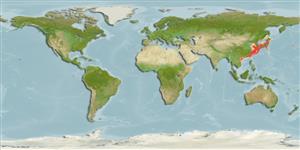Common names from other countries
Environment: milieu / climate zone / depth range / distribution range
Ecologia
marinhas batidemersal; intervalo de profundidade 25 - 560 m (Ref. 11230). Deep-water
Northwest Pacific: Japan, Korea, and the Yellow and East China seas.
Length at first maturity / Tamanho / Peso / Idade
Maturity: Lm 52.7, range 39 - 63 cm
Max length : 150 cm SL macho/indeterminado; (Ref. 559); peso máx. Publicado: 3.5 kg (Ref. 124479)
Found in sandy mud bottom (Ref. 11230). A carnivore (Ref. 9137). Mainly feed on fish, euphausiids, sagittoids and shrimps (Ref. 53326). Used in Chinese medicine (Ref. 12166). Consumed as food, liver considered as delicacy in Japan (Ref. 47220).
Masuda, H., K. Amaoka, C. Araga, T. Uyeno and T. Yoshino, 1984. The fishes of the Japanese Archipelago. Vol. 1. Tokai University Press, Tokyo, Japan. 437 p. (text). (Ref. 559)
Categoria na Lista Vermelha da IUCN (Ref. 130435)
CITES (Ref. 128078)
Not Evaluated
Ameaça para o homem
Harmless
Utilização humana
Pescarias: espécies comerciais
Mais informação
ReferênciasAquaculturaPerfil para aquaculturaEstirpesGenéticaElectrophoresesHereditariedadeDoençasProcessamentoMass conversion
ColaboradoresFotografiasStamps, Coins Misc.SonsCiguateraVelocidadeTipo de nataçãoÁrea branquialOutras referênciasCérebrosVisão
Ferramentas
Relatórios especiais
Descarregue XML
Fontes da internet
Estimates based on models
Preferred temperature (Ref.
115969): 5.6 - 20.9, mean 17.4 (based on 173 cells).
Phylogenetic diversity index (Ref.
82804): PD
50 = 0.5078 [Uniqueness, from 0.5 = low to 2.0 = high].
Bayesian length-weight: a=0.01413 (0.00980 - 0.02036), b=3.00 (2.90 - 3.10), in cm Total Length, based on LWR estimates for this species (Ref.
93245).
Nível Trófico (Ref.
69278): 4.1 ±0.70 se; based on food items.
Resiliência (Ref.
120179): Baixo, tempo mínimo de duplicação da população 4,5 - 14 anos (tm=6.2; Fec=310,000 (batch fecundity)).
Fishing Vulnerability (Ref.
59153): Very high vulnerability (90 of 100).
